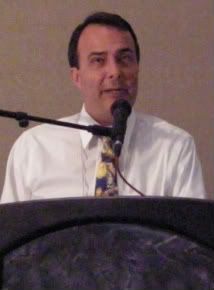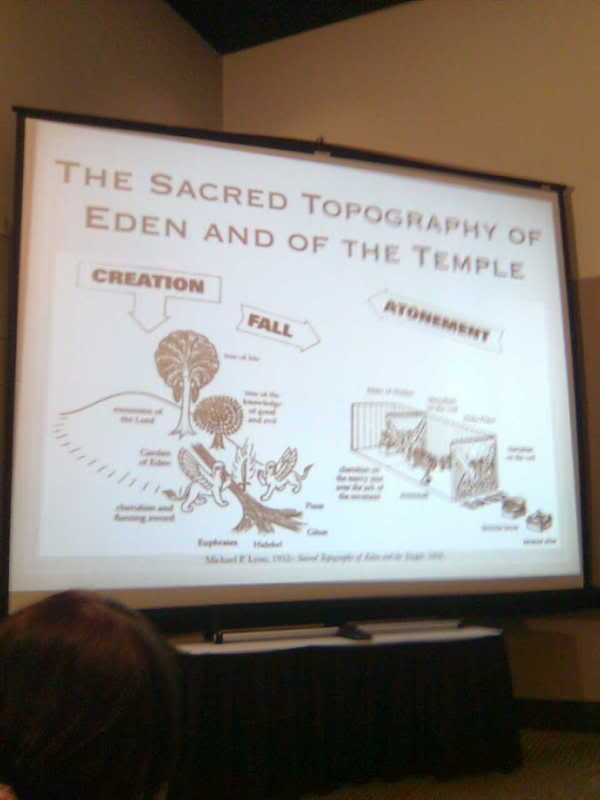Jeffrey Bradshaw: The Message of the Joseph Smith Translation: A Walk in the Garden
Bradshaw structured his talk around the concept of the Garden story in Genesis, Moses, and other sources. It was a very involved presentation, only a few points are noted here, and much of the presentation includes important images. Thus, I strongly advise reading the full presentation in the future when released through FAIR. I hope to work on a transcription. Bradshaw also has a book forthcoming which covers this topic and more. Bradshaw's book In God's Image and Likeness, which has a lot of this stuff
in it, is slated for publication by Greg Kofford books in
late 2009.
 Bradshaw sees the inspired translation of the Bible by Joseph Smith was an opportunity for the prophet to be educated in gospel matters. While the Lord apparently felt it less important that the translation be published during the prophet's life, there was much importance in his translation nonetheless.
Bradshaw sees the inspired translation of the Bible by Joseph Smith was an opportunity for the prophet to be educated in gospel matters. While the Lord apparently felt it less important that the translation be published during the prophet's life, there was much importance in his translation nonetheless. What was importance in doing Genesis? Bradshaw believes that the first JST chapters lend into the concept of consecration, but the most significant part was regarding the Temple. This would suppose that JS knew more about temple ordinances earlier than supposed (namely, before the Kirtland temple). He knew more than he publicly shared, in other words. The prophet delayed publication on JST things (and D&C 132, Moses, etc.) until the Nauvoo period, though he received it much earlier. [Did Joseph know fully early on?] He was commanded not to show unto any except a few at first, regarding Moses which has some temple information.
Moses Ch. 2-4 on the creation, fall, etc. which do not differ too much from the KJV. Compare the difference of the creation as revealed to Moses compared to the revelation in Abraham. Nibley, Barker and others say the creation account was teaching the creation of the Temple. The creation account parallels the creation of the Tabernacle. Donald Parry argued that the garden of eden should be seen as a natural temple, then. He showed a very interesting diagram here of the creation fall and atonement in regards to the temple etc.
Tree of Life
Trees often stand for Christ and His attributes. The menorah had a parallel to the burning bush; thus God was represented as one who dwells in the burning bush, and represented by the menorah. This would also represent the Tree of Life. This tree was later removed from the temple [Asherah] Bradshaw continues to talk about the tree in various cultural views. Assyrian, etc.
Location of the Tree
Tree of Life/Tree of Knowledge in the midst of the garden.
Basically, Bradshaw is focusing on three zones of sacredness within Eden.
Outer Courtyard/Telestial world/Lone and Dreary
Holy place/Terrestrial/Garden
Holy of Holies/Celestial/God's place there, the tree.
Again, Bradshaw shows various images, art, religious iconography of the tree and relates it to creation, etc.
Why did Satan encourage eating of the forbidden fruit? He had his own motives, wanting them to eat of the tree of life directly after the tree of knowledge, thus no probationary state.
What was the fruit? Satan said he would reveal to Adam and Eve 3 mysterious words which will protect from death. Satan revealed these secrets that were done in other worlds, but it was not his role nor was it the time, thus what he did was wrong. Satan tries to confuse Eve. Barker said Satan made the 2 trees seem identical, the tree of knowledge would make her as gods knowing good and evil, the tree of life would give the immortality then.
In the Qur'an Satan says the tree is the tree of immortality, whereas in actuality it was the tree of spiritual death.
 Aprons from fig leaves. Figs had abundance of seeds, hence be fruitful. Aprons have long been used in ritual contexts. Charlemagne is depicted with an apron with foliage on it. Adam and Eve made themselves aprons. This is the attempt and failure of attaining the blessings on their own efforts, just like taking the fruit to gain blessings on their own volition, hence Satan suggested they use aprons.
Aprons from fig leaves. Figs had abundance of seeds, hence be fruitful. Aprons have long been used in ritual contexts. Charlemagne is depicted with an apron with foliage on it. Adam and Eve made themselves aprons. This is the attempt and failure of attaining the blessings on their own efforts, just like taking the fruit to gain blessings on their own volition, hence Satan suggested they use aprons. Western art show Adam and Eve naked in Eden, whereas the Eastern Orthodox show them as clothed, in other words, Adam is clothed in royal robes in the garden, these are lost in going to the lone and dreary world. He is then clothed in flesh, veiling the royal nature.
Bradshaw talks of the "blows of death" administered to Adam, then Seth is sent to retrieve a branch from the tree with oil of mercy to anoint and heal the wounds on all parts of body.
The cross was seen as a tree of life, healing the wounds of the blows of death, etc. Though all of us have taken of the tree in sinning, Jesus provides the oil of healing to atone heal and restore.
See also, Temples of the Ancient World from FARMS.





1 comment:
Check out this Podcast about the Tree of Life from an Islamic point of view.
http://www.hotconflict.com/blog/2008/06/mystical-connection-between-sufi-islam-and-jewish-kabalah---tree-of-life.html
Post a Comment
All views are welcome when shared respectfully. Use a name or consistent pseudonym rather than "anonymous." Deletions of inflammatory posts will be noted. Thanks for joining the conversation.